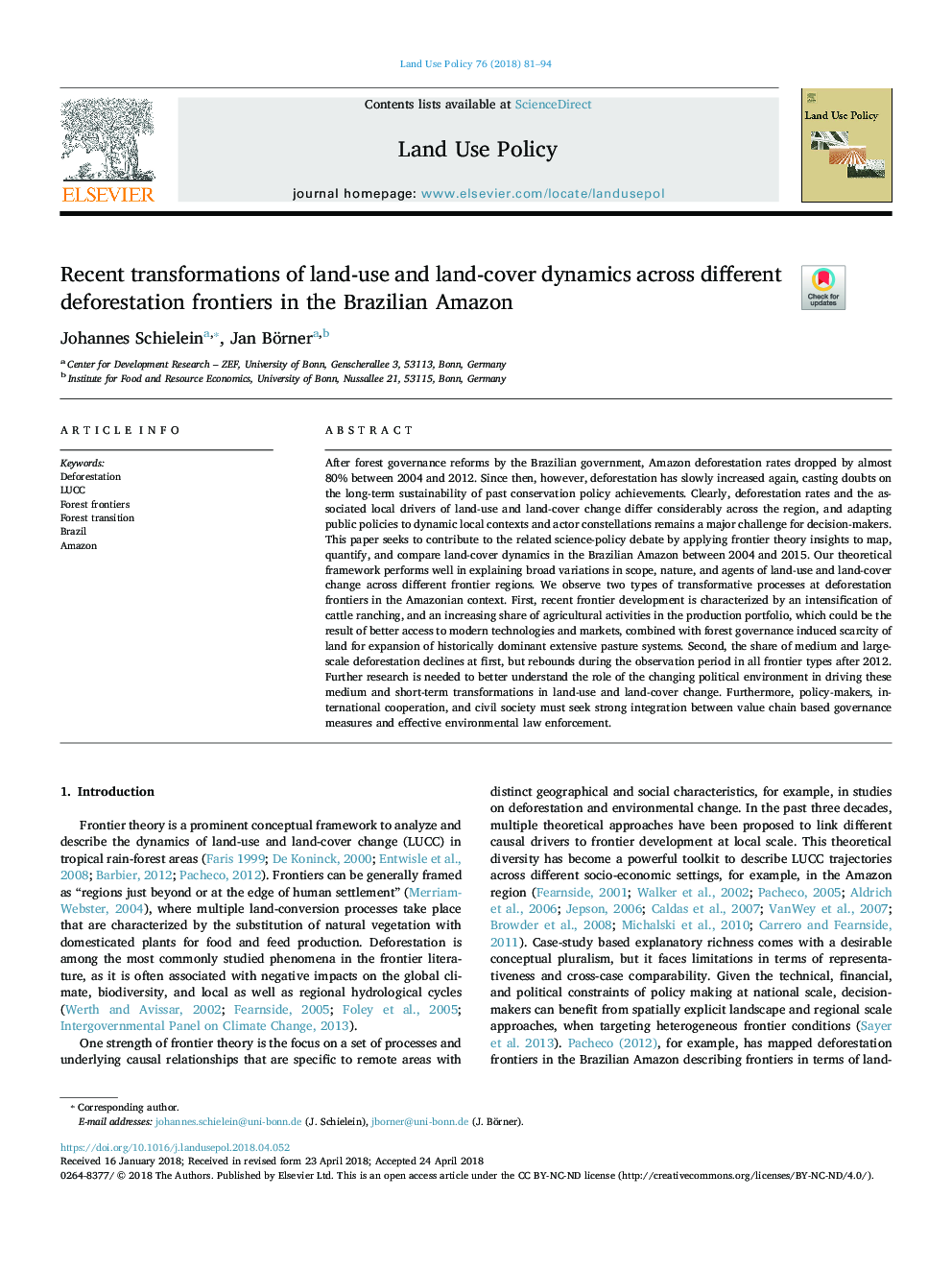| کد مقاله | کد نشریه | سال انتشار | مقاله انگلیسی | نسخه تمام متن |
|---|---|---|---|---|
| 6546240 | 1421807 | 2018 | 14 صفحه PDF | دانلود رایگان |
عنوان انگلیسی مقاله ISI
Recent transformations of land-use and land-cover dynamics across different deforestation frontiers in the Brazilian Amazon
ترجمه فارسی عنوان
تحولات اخیر در زمینه استفاده از زمین و پوشش زمین در سراسر مناطق مختلف جنگل زدایی در آمازون برزیل
دانلود مقاله + سفارش ترجمه
دانلود مقاله ISI انگلیسی
رایگان برای ایرانیان
کلمات کلیدی
ترجمه چکیده
پس از اصلاحات اداری جنگلداری توسط دولت برزیل، میزان جنگل زدایی آمازون بین سالهای 2004 تا 2012 تقریبا 80 درصد کاهش یافت. از آن زمان پس از آن، جنگل زدایی به تدریج افزایش یافت، و شک و تردید در مورد ثبات درازمدت پیشرفت های گذشته حفاظت از منابع طبیعی بود. واضح است که نرخ های جنگل زدایی و رانندگان محلی مرتبط با استفاده از زمین و پوشش زمین در سراسر منطقه بطور قابل توجهی متفاوت است و تطبیق سیاست های عمومی به شرایط محلی پویا و صور فلکی بازیگر همچنان یک چالش عمده برای تصمیم گیران است. این مقاله به دنبال مشارکت در بحث مربوط به علم سیاست با استفاده از بینش نظریه مرزها برای تعیین، اندازه گیری و مقایسه پویایی پوشش زمین در آمازون برزیل بین سال های 2004 تا 2015 است. چارچوب نظری ما در توضیح تغییرات گسترده در دامنه، طبیعت ، و عوامل تغییر کاربری زمین و پوشش سرزمین در مناطق مختلف مرزی. ما دو نوع از فرایندهای تغییر در مرزهای جنگل زدایی را در زمینه آمازون مشاهده می کنیم. اولا، توسعه مرزهای اخیر با تشدید گاو گاو و افزایش سهم فعالیت های کشاورزی در نمونه های تولید مشخص می شود که می تواند منجر به دسترسی بهتر به فن آوری های مدرن و بازار شود، در کنار اداره جنگل ناشی از کمبود زمین برای توسعه از سیستم های گسترده ای از مرتع پرورش یافته تاریخی غالب. دوم، سهم جنگل زدایی متوسط و بزرگ در ابتدا کاهش می یابد، اما در طول دوره مشاهده در تمام گونه های مرزی پس از سال 2012 کاهش می یابد. تحقیقات بیشتری برای شناخت بهتر از نقش متغیر سیاسی در رانندگی این متوسط و کوتاه مدت تغییرات در تغییر کاربری زمین و زمین. علاوه بر این، سیاستگذاران، همکاری بین المللی و جامعه مدنی باید به دنبال یکپارچگی قوی بین اقدامات حکومتی بر پایه زنجیره ارزش و اجرای قانون موثر محیط زیست باشند.
موضوعات مرتبط
علوم زیستی و بیوفناوری
علوم کشاورزی و بیولوژیک
جنگلداری
چکیده انگلیسی
After forest governance reforms by the Brazilian government, Amazon deforestation rates dropped by almost 80% between 2004 and 2012. Since then, however, deforestation has slowly increased again, casting doubts on the long-term sustainability of past conservation policy achievements. Clearly, deforestation rates and the associated local drivers of land-use and land-cover change differ considerably across the region, and adapting public policies to dynamic local contexts and actor constellations remains a major challenge for decision-makers. This paper seeks to contribute to the related science-policy debate by applying frontier theory insights to map, quantify, and compare land-cover dynamics in the Brazilian Amazon between 2004 and 2015. Our theoretical framework performs well in explaining broad variations in scope, nature, and agents of land-use and land-cover change across different frontier regions. We observe two types of transformative processes at deforestation frontiers in the Amazonian context. First, recent frontier development is characterized by an intensification of cattle ranching, and an increasing share of agricultural activities in the production portfolio, which could be the result of better access to modern technologies and markets, combined with forest governance induced scarcity of land for expansion of historically dominant extensive pasture systems. Second, the share of medium and large-scale deforestation declines at first, but rebounds during the observation period in all frontier types after 2012. Further research is needed to better understand the role of the changing political environment in driving these medium and short-term transformations in land-use and land-cover change. Furthermore, policy-makers, international cooperation, and civil society must seek strong integration between value chain based governance measures and effective environmental law enforcement.
ناشر
Database: Elsevier - ScienceDirect (ساینس دایرکت)
Journal: Land Use Policy - Volume 76, July 2018, Pages 81-94
Journal: Land Use Policy - Volume 76, July 2018, Pages 81-94
نویسندگان
Johannes Schielein, Jan Börner,
